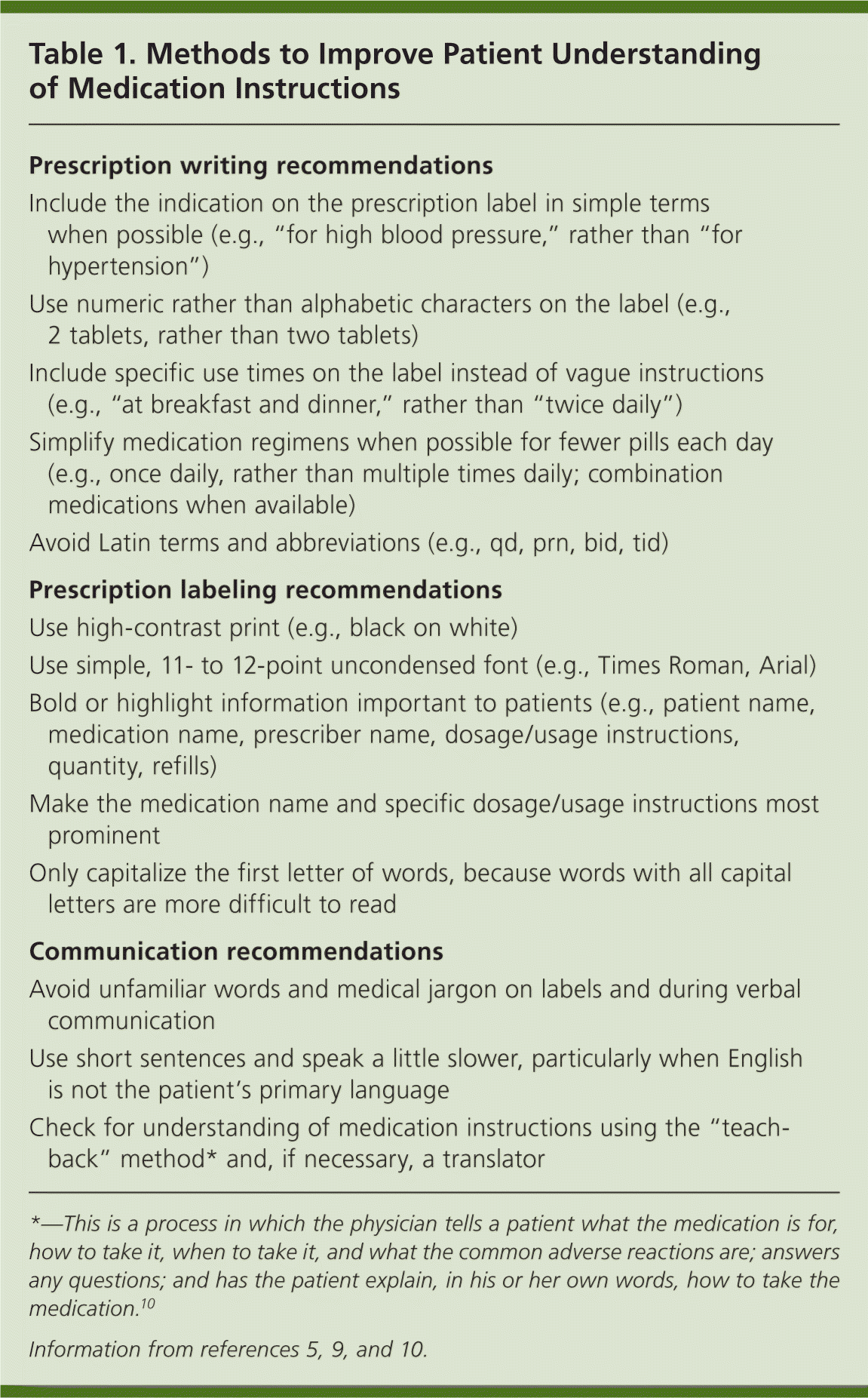
Am Fam Physician. 2013;87(11):755-756
Author disclosure: No relevant financial affiliations.
In the United States, 80 million adults have substantial difficulties with reading,1 and only 12% of adults are considered proficient in health literacy.2 Approximately 1.5 million adverse drug events occur each year,3 resulting in 117,000 hospitalizations annually at significant human and financial cost.4 Prescription standards and recommendations exist,5,6 but are not universally adopted. Clear and concise prescription writing and labeling that explain the use of medications, and confirming a patient's understanding of the instructions can help improve adherence and reduce medication errors.
In the hospital, there is significant oversight of medications, but in the ambulatory environment, patients are often left on their own to take their medications correctly.4 Studies have found that 46% of patients misunderstood one or more dosing instructions,7 and 56% misunderstood one or more auxiliary warnings.8 Populations at greatest risk of adverse drug events are patients younger than five years or older than 65 years,4 and patients whose primary language is not English. Health communication research has shown that physicians are the most trusted source of information about medications and health, but time constraints limit physicians from explaining new medications as thoroughly as possible.9
There are four points in the prescribing process in which evidence suggests changes in practices may lead to improved patient understanding and reduce medication mistakes. These include when (1) the prescription is written (telling the pharmacist what to put on the medication label)5,6,9; (2) the prescriber gives administration instructions to the patient10; (3) the instructions are printed on the container label5,6,9; and (4) the pharmacist dispenses the prescription.10
The container label is the patient's primary guide for medication use,9 so most of the recommendations and standards are about labeling. Historically, each state regulates prescription labeling and the U.S. Food and Drug Administration regulates over-the-counter medication labeling. Some states have recently passed legislation in an effort to decrease medication errors, with initiatives ranging from standardization of medication labels to requiring legible prescriptions and electronic prescriptions.11 The U.S. Pharmacopeia has recommended new prescription medication labeling standards based on evidence related to features of a medication label that enhance understanding, especially for persons with limited health literacy. The new recommendations were released in November 2012. Enforcement of the standard will be the decision of the Board of Pharmacy in each state. Standards and a sample medication label illustrating key elements of the standards are available for free from the U.S. Pharmacopeia at http://www.usp.org/usp-nf/key-issues/usp-nf-general-chapter-prescription-container-labeling.
One example of a medication instruction that is particularly troublesome for patients is “take two pills by mouth twice daily.” It is the word “twice” that seems to cause the most trouble. In one workshop on health literacy in patient care, many patients with limited health literacy were able to accurately repeat this dosing instruction back to researchers, but were able to count out the correct number of pills they should take in one day (four) only 37% of the time. Even those with “adequate” health literacy demonstrated the correct dose only 71% of the time. Simply changing the instructions to “take two pills with breakfast and two pills with dinner” improved the number of correct responses to 76% in the low-literacy group and to 92% in the high-literacy group.12
One proven way that prescribers and pharmacists can make sure that patients understand how to take their medication is through the “teach-back” method. This is a process in which the physician tells a patient what the medication is for, how to take it, when to take it, and what the common adverse reactions are; answers any questions; and has the patient explain, in his or her own words, how to take the medication. This generally takes 90 seconds.10
Table 1 lists key recommendations for improving a patient's understanding of medication instructions.5,9,10 It will take prescribers, pharmacists, and their respective teams addressing all of these recommendations to maximize patient understanding of prescription instructions. We ask our patients to change their behavior every time we give them a prescription, so is it not time we changed ours?

| Prescription writing recommendations |
| Include the indication on the prescription label in simple terms when possible (e.g., “for high blood pressure,” rather than “for hypertension”) |
| Use numeric rather than alphabetic characters on the label (e.g., 2 tablets, rather than two tablets) |
| Include specific use times on the label instead of vague instructions (e.g., “at breakfast and dinner,” rather than “twice daily”) |
| Simplify medication regimens when possible for fewer pills each day (e.g., once daily, rather than multiple times daily; combination medications when available) |
| Avoid Latin terms and abbreviations (e.g., qd, prn, bid, tid) |
| Prescription labeling recommendations |
| Use high-contrast print (e.g., black on white) |
| Use simple, 11- to 12-point uncondensed font (e.g., Times Roman, Arial) |
| Bold or highlight information important to patients (e.g., patient name, medication name, prescriber name, dosage/usage instructions, quantity, refills) |
| Make the medication name and specific dosage/usage instructions most prominent |
| Only capitalize the first letter of words, because words with all capital letters are more difficult to read |
| Communication recommendations |
| Avoid unfamiliar words and medical jargon on labels and during verbal communication |
| Use short sentences and speak a little slower, particularly when English is not the patient's primary language |
| Check for understanding of medication instructions using the “teach-back” method* and, if necessary, a translator |
